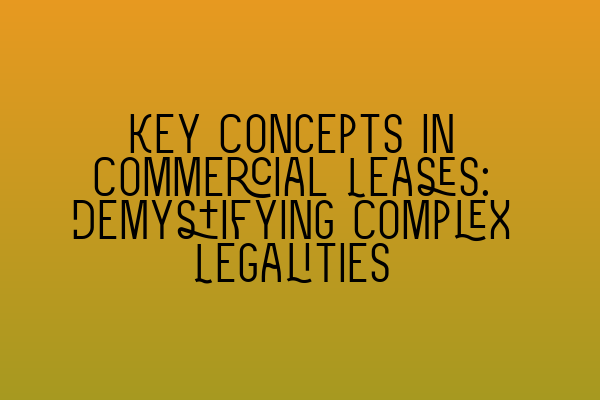Key Concepts in Commercial Leases: Demystifying Complex Legalities
Commercial leases are an integral part of the real estate industry, governing the legal relationship between landlords and tenants. However, understanding the complex legalities and key concepts involved in commercial leases can be challenging for both parties. In this article, we aim to demystify some of the essential elements of commercial leases, providing clarity and guidance for landlords and tenants alike.
1. Definition and Purpose of a Commercial Lease
A commercial lease is a legally binding contract that allows a tenant to occupy and use a property for commercial purposes in exchange for rent payments. It outlines the rights and responsibilities of both the landlord and the tenant and provides a framework for the lease term.
To fully comprehend the intricacies of commercial leases, it is crucial to understand the key concepts that govern them, including:
2. Lease Term and Rent
The lease term refers to the duration for which the tenant has the right to occupy the property. This includes the start and end dates of the lease, along with any renewal or termination clauses. Rent, on the other hand, is the monetary consideration paid by the tenant to the landlord for the use of the property.
Understanding the lease term and rent provisions is essential for both landlords and tenants to ensure a fair and mutually beneficial agreement. Landlords should consider market rates and evaluate the potential for rent escalation, while tenants must assess their ability to sustain rent payments for the agreed-upon term.
3. Maintenance and Repair
Another crucial aspect of commercial leases is the allocation of maintenance and repair responsibilities between the landlord and the tenant. These provisions determine who is responsible for maintaining the property, making necessary repairs, and ensuring compliance with building codes and regulations.
Clear and precise maintenance and repair clauses are imperative to avoid disputes and ensure that the property remains in good condition throughout the lease term. Before entering into a commercial lease, both landlords and tenants should carefully review these provisions and address any ambiguities.
4. Use and Alterations
The use clause defines the specific purpose for which the leased property can be used by the tenant. It may restrict certain activities or limit the property’s use to specific industries. Tenants should ensure that the use clause aligns with their business requirements, while landlords should include appropriate restrictions to protect the property and the surrounding community.
Alteration clauses govern any modifications or renovations that the tenant wishes to make to the leased property. These provisions outline the process for seeking landlord’s approval, obtaining necessary permits, and restoring the property to its original condition at the end of the lease term.
5. Assignment and Subletting
Assignment and subletting provisions address the tenant’s rights to transfer the lease or sublease the property to another party. Landlords often include restrictions on assignment and subletting to maintain control over the tenants occupying their properties.
Tenants should carefully review these clauses to understand their options in case they need to assign the lease or sublet the property due to changing business circumstances. Landlords, on the other hand, need to consider the potential impact on the property and the overall tenant mix before granting such rights.
6. Rent Review and Termination
Rent review clauses provide a mechanism for adjusting the rent during the lease term. These clauses typically outline the frequency of rent reviews, the method for calculating adjustments, and any applicable caps or floors.
Termination clauses specify the conditions under which either party can terminate the lease before the agreed-upon term. It is crucial for both landlords and tenants to understand the termination provisions to protect their rights and determine the potential financial implications of early termination.
Conclusion
Commercial leases can be complex and intimidating, but by understanding the key concepts discussed in this article, both landlords and tenants can navigate the legalities with ease. By clarifying the definitions and purposes of commercial leases, along with essential elements such as lease term, rent, maintenance and repair, use and alterations, assignment and subletting, and rent review and termination, we hope to demystify the world of commercial leases.
If you are preparing for the SQE exams or seeking to expand your knowledge in property law, we recommend exploring our related articles:
- SQE 1 Practice Exam Questions
- SQE 1 Practice Mocks FLK1 FLK2
- SQE 2 Preparation Courses
- SQE 1 Preparation Courses
- SRA SQE Exam Dates
At SQE Property Law & Land Law, we offer comprehensive preparation courses designed to equip you with the knowledge and skills needed to excel in your property law journey. Contact us today to learn more about our courses and how we can support your professional growth.
